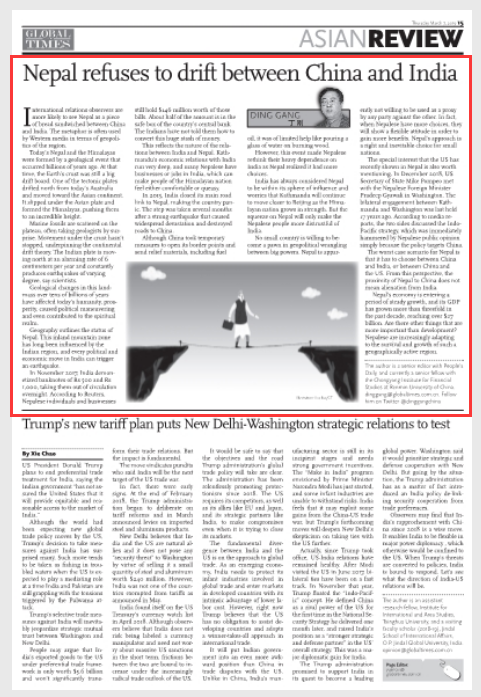Major Power Relations
Your Present Location: PROGRAMS> Major Power RelationsDing Gang: Nepal refuses to drift between China and India
By Ding Gang Source: Global Times Published: 2019-3-6
International relations observers are more likely to see Nepal as a piece of bread sandwiched between China and India. The metaphor is often used by Western media in terms of geopolitics of the region.

Today's Nepal and the Himalayas were formed by a geological event that occurred billions of years ago. At that time, the Earth's crust was still a big drift board. One of the tectonic plates drifted north from today's Australia and moved toward the Asian continent. It slipped under the Asian plate and formed the Himalayas, pushing them to an incredible height.
Marine fossils are scattered on the plateau, often taking geologists by surprise. Movement under the crust hasn't stopped, underpinning the continental drift theory. The Indian plate is moving north at an alarming rate of 6 centimeters per year and constantly produces earthquakes of varying degree, say scientists.
Geological changes in this landmass over tens of billions of years have affected today's humanity, prosperity, caused political maneuvering and even contributed to the spiritual realm.
Geography outlines the status of Nepal. This inland mountain zone has long been influenced by the Indian region, and every political and economic move in India can trigger an earthquake.
In November 2017, India demonetized banknotes of Rs 500 and Rs 1,000, taking them out of circulation overnight. According to Reuters, Nepalese individuals and businesses still hold $146 million worth of those bills. About half of the amount is in the safe box of the country's central bank. The Indians have not told them how to convert this huge stash of money.
This reflects the nature of the relations between India and Nepal. Kathmandu's economic relations with India run very deep, and many Nepalese have businesses or jobs in India, which can make people of the Himalayan nation feel either comfortable or queasy.
In 2015, India closed its main road link to Nepal, making the country panic. The step was taken several months after a strong earthquake that caused widespread devastation and destroyed roads to China.
Although China took temporary measures to open its border points and send relief materials, including fuel oil, it was of limited help like pouring a glass of water on burning wood.
However, this event made Nepalese rethink their heavy dependence on India as Nepal realized it had more choices.
India has always considered Nepal to be within its sphere of influence and worries that Kathmandu will continue to move closer to Beijing as the Himalayan nation grows in strength. But the squeeze on Nepal will only make the Nepalese people more distrustful of India.
No small country is willing to become a pawn in geopolitical wrangling between big powers. Nepal is apparently not willing to be used as a proxy by any party against the other. In fact, when Nepalese have more choices, they will show a flexible attitude in order to gain more benefits. Nepal's approach is a right and inevitable choice for small nations.
The special interest that the US has recently shown in Nepal is also worth mentioning. In December 2018, US Secretary of State Mike Pompeo met with the Nepalese Foreign Minister Pradeep Gyawali in Washington. The bilateral engagement between Kathmandu and Washington was last held 17 years ago. According to media reports, the two sides discussed the Indo-Pacific strategy, which was immediately hammered by Nepalese public opinion simply because the policy targets China.
The worst case scenario for Nepal is that it has to choose between China and India, or between China and the US. From this perspective, the proximity of Nepal to China does not mean alienation from India.
Nepal's economy is entering a period of steady growth, and its GDP has grown more than threefold in the past decade, reaching over $27 billion. Are there other things that are more important than development? Nepalese are increasingly adapting to the survival and growth of such a geographically active region.
The author is a senior editor with People's Daily, and currently a senior fellow with the Chongyang Institute for Financial Studies at Renmin University of China.























































































 京公网安备 11010802037854号
京公网安备 11010802037854号





